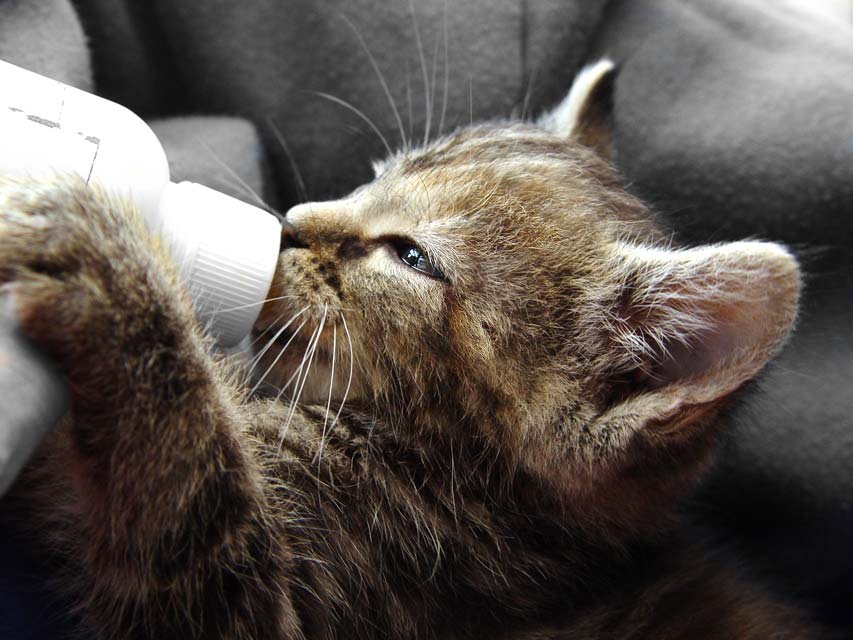How to Care for Orphaned Kittens

Spring is on its way. The days grow longer, the weather warms, and like clockwork, Mother Nature yields another bumper crop of baby kittens. Mother cats are usually impeccable moms, but occasionally, things go wrong. Accidents happen, illness occurs, maternal stress or inexperience takes a toll, and single kittens can get separated from the group. Little orphans turn up in back yards, under porches, or mewing loudly by your back door.
What to Do if You Suspect Kittens Are Orphaned
If you’ve come across a litter of feral kittens squirreled away somewhere, your best bet may be to watch and wait. The mother cat may be coming back, says Olivia Cunningham, a veterinary technician and veteran feline foster mom from Boston, MA. "If the mother cat is healthy and able, you’re light years ahead."
Infant kittens do best with their mothers' milk, which contains just the right nutrition, along with critical antibodies for the developing immune system. Not to mention that having the mom cat around can save you a lot of effort. Consider offering shelter and nutrition to the mom and her young family, at least until the kittens are weaned and the mom can be spayed. This is typically around 4-6 weeks postpartum.
Sometimes, having the mom cat around isn’t an option. If the kittens are alone and appear weak, chilled, or soiled or have been left out in the open, it’s likely that mom isn’t coming back, says Olivia. Abandoned kittens can quickly die of exposure, so immediate action may be required. Your options include rushing the kittens to a local shelter or taking on the task yourself. If you’re going to be a foster parent, get ready for several weeks of round-the-clock effort that can be both exhausting and exhilarating at the same time.
Keep the Kittens Warm
Newborn kittens are incapable of maintaining their own body heat. They are utterly dependent on the mother, or you, by default, for warmth for the first three weeks. Kittens quickly enter a downward spiral when they get cold. The metabolism slows, they become too weak to nurse, blood sugar drops, making them even weaker and bringing the metabolism to a halt. Coma and death can quickly follow. Gently warm a kitten until it is alert and mewing for food. If the kitten is warmed but still dull or unwilling to nurse, this can indicate trouble. Seek veterinary care without delay. Never feed a kitten that is chilled and too weak to nurse. This can be fatal.
| Age in weeks | Temperature (°F) |
|---|---|
| <1 | 85 to 90 |
| 1-2 | 80-85 |
| 2-3 | 75-80 |
| 3-4 | 70-75 |
| 4+ | 70 |
Keep your tiny tigers snuggly and warm in an improvised nest made from a high-sided box, crate, or pet carrier lined with soft blankets. An electric heating pad is a convenient way to maintain the ideal ambient temperature (see box) but it must be used with extreme caution to avoid burns. Wrap the heating pad in a thick towel, then place it under one half of the nest. This softens the heat and allows the kittens to retreat to a cooler spot when needed. Placing a chilled kitten against a warm water bottle or next to your skin works well in a pinch.
Take Orphaned Kittens to the Vet
Once your kittens are safe, warm, and fed (see Nutrition, below), it’s time to visit the vet. The veterinarian will do a full physical exam, estimate their age, screen for infections, parasites, and other health problems, and advise on age-appropriate nutrition and care. Sick kittens may require emergency treatment such as subcutaneous fluids, antibiotics, or tube feeding to get them over the hump.
Quarantine of Orphaned Kittens
Resist the temptation to share your little bundles of joy with the other pets in your home at first. Cute as they may be, baby kittens can carry infections and harbor parasites that can be dangerous or even deadly to other pets. Plan to quarantine the kittens for at least two weeks, even after they’ve been officially "vetted."
Nutrition for Orphaned Kittens
Feeding techniques and recommendations are covered extensively elsewhere in print and on the web. Here are a few highlights. Follow this link for a helpful video tutorial.
- Always use kitten formula. There are several brands of kitten formula for purchase at pet supply stores and veterinary offices. Liquid and powdered formulations are available. Liquid is more convenient, whereas powdered is generally more economical. KMR is one popular brand.
- Never feed cow’s milk to kittens. This includes condensed milk products. It can cause harmful or fatal digestive problems.
- Use a kitten nurser. Kitten nursers look like miniature baby bottles and can be purchased wherever formula is sold. An eyedropper or small syringe can work well, too.
- Avoid aspiration. Never feed a kitten in prone (belly-up) position. This increases the risk that formula can be inhaled into the kitten’s lungs. Feed with at least the back feet touching your lap.
- Never feed a cold kitten. This can lead to severe digestive problems and can be fatal. Similarly, it’s not safe to feed a kitten that is sleepy or unresponsive. Formula could end up in the lungs. Wait until the kitten is warmed and mewing for food.
- Don’t overfeed. A kitten will slow down and look content and sleepy when she’s had enough. The belly will be round and full. Don’t force-feed past this point.
- Feed small amounts often. Infant kittens need to be fed as often as every four hours around the clock. For helpful info on how much to feed and how often, a very informative website Feralcat.com, offers several helpful metrics.
Potty Time for Orphaned Kittens
Is Your Kitten a Boy or Girl?
Determining the sex can be challenging in very young kittens. To find out, check under the tail. A female's genital opening is a small slit that lies just below the anus. A male's genital opening is a round hole that is spaced farther below the anus. The testicles will descend and occupy this space by about three to four weeks of age. The distinction can be clearer by doing a side-to-side comparison of male and female litter-mates.
Kittens aged three weeks and under are unable to pee and poop on their own. The mother cat normally helps things along by licking and cleaning under their tiny tails to make them void. If mom’s not around, this is up to you.
The procedure is as follows: with a warm, wet washcloth or cotton ball, firmly rub the kitten’s anus and genital area in a back-and-forth motion until the baby urinates and defecates. The stool should be formed, and the urine should be clear. If not, consult your veterinarian. Stimulate the kittens to go before and after each feeding to avoid urine or stool retention.
Housekeeping Concerns When Caring for Orphaned Kittens
Cleaning up after very young kittens is a truly unrelenting job that makes one appreciate how hardworking mother cats are. The task of maintaining hygiene peaks at three to four weeks of age, when toddler kittens traipse blithely through water dishes, food bowls, and litter pans leaving destruction in their wake. "You do a lot of laundry," says Olivia Cunningham. Refresh bedding, food, and water as needed, and disinfect the bedding daily using 3/4 cup bleach per full load of wash (1-1/4 cups in extra large washers) and the hottest water setting. This helps prevent the spread of infection. Baby kittens need regular warm-water sponge baths to keep them clean, sweet-smelling and free of rashes and skin infections. And don’t forget to wash your hands before and after handling the kittens. This is for everyone’s safety.
Developmental Milestones of Kittens
| Age | Characteristics |
|---|---|
| Under 4 days | Eyes and ears are closed. The kitten curls in a comma shape. It is able to squeal with hunger and move toward warmth. Umbilical cord may still be attached. Weight: 3-4 oz. |
| 5-7 days | Ears open. Can orient to smells. Weighs 6-8 ounces. |
| 1-2 weeks | Eyes open. Getting ready to crawl. |
| 2-3 weeks | Takes first tentative steps. Baby teeth begin to erupt. Weighs 8-10 ounces. |
| 3-4 weeks | Walking, wobbly at first. Can orient to sights and sounds. Begins socializing with other kittens. Able to regulate body temperature on own. Weighs 10-12 ounces. |
| 4 weeks | Can eat solid foods, eliminate on own, beginning to use litter pan. Walking well. Learning to leap and pounce. Self-grooming begins. Eyes begin changing from blue to green and then yellow. Weighs 14 ounces and up. |
Weaning, Litter Training, and Beyond
By three to four weeks, toddler kittens are ready to start eating solids. Begin by mixing pureed canned kitten food with kitten formula and offer it, slightly warmed, in a small flat dish. The kittens will probably traipse through it at first and then quickly discover the mysterious goo on their paws tastes delicious. As they get the hang of it, you can begin increasing the proportion of canned food in the ration. Within a week or so, the kittens should be able to eat straight canned food on their own. At this point, you can provide the gang with a low, tip-proof water bowl. This might make a fun wading pool at first. Eventually, kittens learn to eat and drink like the best of them.
With weaning under way, it’s time to introduce a litter pan. Offer a shallow box (a shoe box lid works perfectly) filled with old-fashioned, unscented, non-clumping clay litter. After some preliminary scratching, digging, and wrestling, instinct kicks in. By five weeks of age, most kittens are using the litter pan like pros.
At five weeks, kittens can also leave the safety of their nest to start exploring their world. This is when the fun starts as kittens practice their primordial hunting skills and entertain us with their zany, playful antics. Allow a kitten to explore in the safety of a small room such as a bathroom (with toilet lid closed!) or small bedroom while under supervision. Socialization is critical at this stage, so be sure to handle, snuggle, and play with the kittens often. This will have a positive lifelong impact.
A Word of Caution About Orphaned Kittens
Raising orphaned kittens can be the hardest job you’ll ever love. It’s impossible not to let those darling and dependent little creatures steal your heart. But realize that even with the best care, infant kittens sometimes die. Infections and unseen birth defects can take a toll. Statistically speaking, as many as one in four kittens dies before the age of six weeks, with many deaths occurring in the first week1 or right around weaning.2 If tragedy strikes, be assured that you did your best, and this was unfortunately just "one of those things."
Saying Goodbye to Your Orphaned Kittens
By eight weeks of age, your kittens are ready to go to their forever homes. After those intense several weeks, saying goodbye can be bittersweet. But with love and a little luck, the little darlings will have you to thank for all nine lives.
You May Also Like These Articles:
Normal Feline Birth and Dystocia
Normal Feline Reproductive Behavior
Worms in Cats: Feline Intestinal Parasites
What Is the Best Type of Cat Litter?
Notice: Ask-a-Vet is an affiliated service for those who wish to speak with a veterinary professional about their pet's specific condition. Initially, a bot will ask questions to determine the general nature of your concern. Then, you will be transferred to a human. There is a charge for the service if you choose to connect to a veterinarian. Ask-a-Vet is not manned by the staff or owners of CatHealth.com, and the advice given should not delay or replace a visit to your veterinarian.






